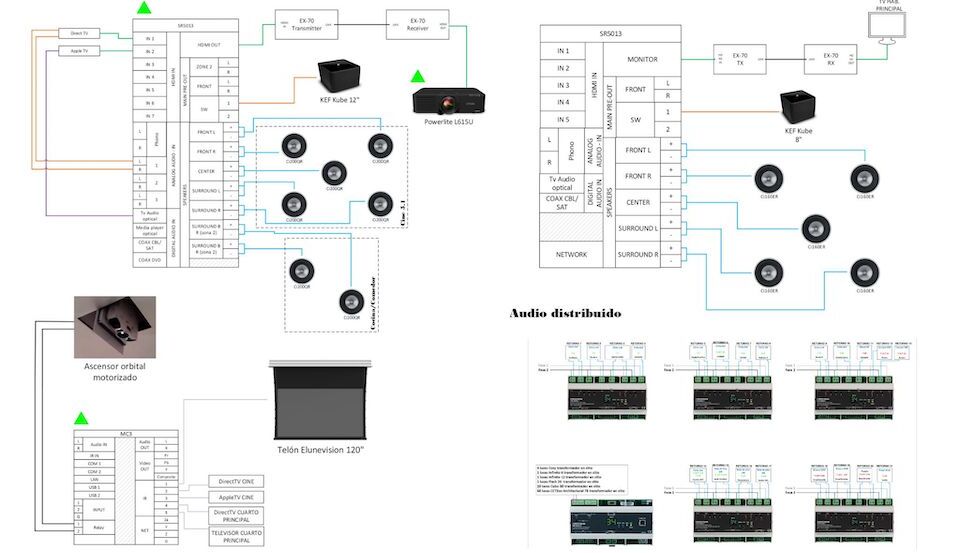Best Center Channel Speaker Placement Practices

Strong 8k brings an ultra-HD IPTV experience to your living room and your pocket.
When setting up a home theater system, the placement of your speakers is critical to achieving optimal sound quality and an immersive audio experience. This is especially true for the center channel speaker, which handles a significant portion of a movie's dialogue and is a key component in any surround sound setup. Proper home theater speaker placement, particularly of the center channel, can make the difference between a mediocre and a truly engaging cinematic experience in your living room.
In this comprehensive guide, we'll dive deep into the best practices for center channel speaker placement. We'll cover the ideal position, height, and angle to get the most out of your center speaker. Additionally, we'll discuss how to integrate your center channel seamlessly with the rest of your speaker array for a cohesive, balanced soundstage. Whether you're a home theater enthusiast or a professional AV system integrator, understanding and implementing these techniques will elevate your audio setup to the next level.
But before we get into the nitty-gritty of center channel placement, let's first understand why this speaker is so important in a surround sound system. In a typical 5.1 or 7.1 configuration, the center channel is responsible for reproducing a movie's dialogue, as well as certain sound effects that are meant to be anchored to the screen. When the center speaker is properly placed, it creates a seamless audio experience where the dialogue seems to emanate directly from the actors' mouths on screen. This enhances the realism and immersion of the movie-watching experience.
On the other hand, poor center channel placement can lead to a disconnected, unnatural sound where the dialogue seems to come from above, below, or to the side of the screen. This can be distracting and take you out of the movie. That's why it's crucial to get the home theater speaker placement right, especially for the center channel.
Throughout this article, we'll provide actionable tips and guidelines to help you achieve the best possible center channel speaker placement in your home theater. We'll also address common challenges and offer solutions to ensure your setup sounds its best. So let's dive in and explore the world of center channel speaker placement!
The Ideal Position for Your Center Channel Speaker
The first and most important factor in center channel speaker placement is its position relative to your TV or projection screen. Ideally, the center speaker should be placed directly above or below the center of the screen. This creates a seamless audio-visual experience where the dialogue appears to come directly from the actors' mouths on screen.
If your center speaker is placed too far to the left or right of the screen, it can cause an audio disconnect where the sound seems to emanate from a different location than the on-screen action. This can be distracting and take you out of the movie-watching experience.
When deciding whether to place the center speaker above or below the screen, there are a few considerations to keep in mind. If your TV is at a height where the center of the screen is close to ear level when seated, placing the center speaker below the screen is often the best option. This allows the sound to emanate from a more natural height relative to the on-screen action.
On the other hand, if your TV is mounted higher on the wall, placing the center speaker above the screen may be preferable. This can help to anchor the sound to the screen and prevent the audio from seeming disconnected from the visuals. In this case, it's important to angle the speaker down towards the listening position to ensure the sound is directed at the audience's ears.
If you have a acoustically transparent projection screen, the ideal placement for the center speaker is actually behind the screen, at the same height as the left and right front speakers. This allows for the most seamless integration of the audio and visuals. However, this setup requires a specialized screen material and a more complex installation, so it's not always feasible for every home theater.
Ultimately, the goal is to have the center channel as close to the center of the screen as possible, both horizontally and vertically. Experiment with placement above and below the screen to see which option works best in your room and provides the most natural, immersive sound.
Setting the Right Height for Your Center Channel
In addition to its left-right position relative to the screen, the height of your center channel speaker also plays a crucial role in its performance. Ideally, the tweeter of the center speaker should be at ear level of the listeners in the primary seating position. This ensures that the high-frequency sounds, which are directional, are aimed directly at the audience's ears for optimal clarity and detail.
If the center speaker is too high or too low relative to the listeners' ears, the high frequencies may be dispersed ineffectively, resulting in a loss of clarity and intelligibility in the dialogue. This can be especially problematic if the speaker is placed far above or below ear level, as the sound may be projected over the listeners' heads or at their feet.
To determine the right height for your center channel, sit in your primary listening position and have a friend measure the distance from the floor to your ears. This is the ideal height for the tweeter of your center speaker. If you have multiple rows of seating, aim for an average ear height across all the seats.
If your center speaker is placed above the screen, you'll need to angle it downwards to direct the sound towards the listeners' ears. Most center channel speakers have built-in adjustments or wedge-shaped designs that allow you to tilt the speaker for proper aim. The goal is to have the tweeter pointing directly at the primary listening position.
If your center speaker is placed below the screen, it may be closer to ear level by default. However, it's still important to check the height and make adjustments if necessary. In some cases, you may need to raise the speaker using a stand or platform to achieve the proper tweeter height.
Keep in mind that the height of your center channel can also affect its integration with the left and right front speakers. Ideally, all three front speakers should have their tweeters at the same height to create a cohesive, balanced soundstage. If the center speaker is significantly higher or lower than the left and right speakers, it can cause an uneven distribution of sound across the front soundstage.
By setting your center channel at the right height and angle, you'll ensure that the dialogue is clear, detailed, and seamlessly integrated with the rest of the soundtrack. This is a critical step in achieving an immersive, lifelike audio experience in your home theater.
Angling Your Center Channel for Optimal Performance
Once you've determined the ideal left-right position and height for your center channel speaker, the next step is to ensure it's angled correctly towards the listening area. Proper angling is crucial for directing the sound to the listeners' ears and achieving optimal performance from your center speaker.
If your center channel is placed below the screen, it should be angled upwards to aim the tweeter directly at the primary listening position. This ensures that the high-frequency sounds, which are the most directional, are projected towards the listeners' ears for maximum clarity and detail.
The angle of the speaker will depend on its height relative to the listeners' ears and the distance between the speaker and the seating area. As a general rule, the speaker should be angled more steeply if it's placed further below ear level or if the seating area is closer to the screen.
To determine the proper angle, sit in your primary listening position and have a friend adjust the tilt of the center speaker until the tweeter is pointing directly at your ears. You can use a laser pointer or a flashlight attached to the front of the speaker to help visualize the angle.
If your center channel is placed above the screen, the same principles apply, but in reverse. The speaker should be angled downwards to aim the tweeter at the listeners' ears. Again, the angle will depend on the height of the speaker relative to ear level and the distance to the seating area.
Some center channel speakers have built-in adjustments that allow you to easily tilt the speaker up or down. Others may require the use of wedges or angled speaker stands to achieve the proper angle. If your speaker doesn't have any built-in angle adjustment, you can use small foam wedges or shims to tilt it to the desired position.
It's important to note that the vertical dispersion of sound varies between different center channel speakers. Some models have a wider dispersion pattern that allows for more flexibility in placement and angling, while others have a narrower sweet spot that requires more precise aiming. Consult your speaker's specifications or manual to understand its dispersion characteristics and adjust your placement accordingly.
By properly angling your center channel speaker, you'll ensure that the dialogue and other critical sounds are projected directly towards the listeners for optimal clarity and intelligibility. This is a key step in achieving a seamless, immersive audio experience in your home theater.
Integrating Your Center Channel with Left and Right Speakers
While the placement of your center channel speaker is crucial, it's equally important to consider how it integrates with your left and right front speakers. The goal is to create a seamless, cohesive soundstage where the audio transitions smoothly between the three front speakers without any gaps or inconsistencies.
Ideally, your left, center, and right speakers should be equidistant from the primary listening position. This ensures that the sound from each speaker reaches the listeners' ears at the same time, creating a balanced, unified front soundstage. If the center speaker is closer or farther away than the left and right speakers, it can cause timing differences that disrupt the cohesiveness of the sound.
In addition to distance, the height and angle of the left and right speakers should also match the center channel as closely as possible. The tweeters of all three front speakers should be at the same height and aimed directly at the primary listening position. This creates a consistent sound field and prevents any vertical discontinuities in the audio.
If your left and right speakers are placed at a different height than your center channel, you may need to adjust their angle to align the tweeters. This can be done using angled speaker stands or by tilting the speakers on their existing stands. The goal is to have all three tweeters pointing at the listeners' ears for optimal high-frequency dispersion.
Another factor to consider is the horizontal spread of your front speakers. In a typical home theater setup, the left and right speakers should be placed at a 22-30 degree angle relative to the center listening position. This creates a wide, immersive soundstage while still maintaining a strong center image.
If the left and right speakers are too close together, the soundstage may feel narrow and constrained. If they're too far apart, the center image may become diffuse and the sound may feel disconnected from the on-screen action. Experiment with different spacing to find the right balance for your room and listening preferences.
Finally, consider the acoustic interaction between your front speakers and the room itself. The sound from each speaker will reflect off the walls, floor, and ceiling, which can affect the overall tonal balance and clarity. To minimize unwanted reflections, consider using acoustic treatments such as absorptive panels or diffusers on the walls adjacent to the speakers.
By carefully integrating your center channel with your left and right front speakers, you'll create a seamless, immersive soundstage that enhances the overall realism and impact of your home theater experience. Take the time to experiment with placement, angling, and room treatments to find the optimal configuration for your specific setup.
Common Challenges and Solutions for Center Channel Placement
While the principles of center channel speaker placement are straightforward, putting them into practice can sometimes be challenging. Here are some common issues you may encounter when setting up your center speaker, along with potential solutions:
Limited space above or below the screen: If your TV is mounted close to the ceiling or a low-standing cabinet, you may not have enough room to place the center speaker in the ideal position. In this case, consider using a smaller center speaker that can fit in the available space. Alternatively, you can mount the speaker above or below the TV using a specialized bracket or stand.
Center speaker is too large for the TV stand: If your center speaker is too wide or deep to fit on your existing TV stand, you may need to use a dedicated speaker stand or shelf. Look for a stand that's the right height and width for your speaker, and make sure it's sturdy enough to support the weight. Alternatively, you can wall-mount the speaker using brackets or a specialized mounting kit.
Acoustically reflective furniture: If your TV stand or cabinet has a hard, reflective surface, it can cause unwanted reflections that interfere with the sound from your center speaker. To mitigate this issue, consider placing an absorbent material such as a foam pad or felt on top of the surface. This will help to dampen reflections and improve the clarity of the dialogue.
Uneven frequency response: If your center speaker sounds thin or lacking in bass compared to your left and right speakers, it may be due to its placement or the acoustics of your room. Try moving the speaker slightly forward or backward to see if it improves the balance. You can also use acoustic treatments such as bass traps or absorptive panels to even out the frequency response.
Dialogue sounds muffled or unclear: If the dialogue from your center speaker sounds muffled or lacks clarity, it may be due to obstruction from the TV or other objects. Make sure there's a clear path between the speaker and the listening position, and angle the speaker to aim directly at the listeners' ears. You can also try adjusting the crossover settings on your AV receiver to ensure the center speaker is handling the appropriate frequency range.
Inconsistent sound between seating positions: If the sound from your center speaker varies significantly between different seating positions, it may be due to the room's acoustics or the speaker's dispersion pattern. Try experimenting with different placement and angling options to find the best compromise for all listeners. You can also use acoustic treatments to help even out the sound across the room.
By being aware of these common challenges and implementing the appropriate solutions, you can overcome obstacles and achieve optimal center channel speaker placement in your home theater. Remember, the key is to experiment and make adjustments until you find the configuration that works best for your specific setup and listening preferences.
Using AV System Integration Software for Optimal Speaker Placement
While the basic principles of center channel speaker placement are essential, achieving truly optimal performance in a complex home theater setup can be challenging. This is where AV system integration software comes in. These powerful tools allow you to model your room, speakers, and seating positions to determine the ideal placement for each component.
One of the key benefits of using AV system integration software is the ability to visualize your speaker setup in 3D. This allows you to see how the sound from each speaker interacts with the room and identify potential issues such as reflections or dead spots. By adjusting the placement and angling of your speakers in the software, you can optimize the sound for your specific room and seating arrangement.
Another advantage of AV system integration software is the ability to simulate different speaker configurations and listening positions. This is particularly useful if you have multiple rows of seating or a complex room layout. By modeling different scenarios, you can determine the best compromise for all listeners and ensure that everyone experiences optimal sound quality.
Some AV system integration software also includes tools for calibrating your speakers and optimizing the sound for your specific room. These tools may include built-in room correction algorithms, equalization settings, and speaker delay adjustments. By fine-tuning these parameters, you can achieve a more balanced, immersive sound that's tailored to your specific setup.
When choosing AV system integration software, look for a program that's compatible with your specific speakers and AV equipment. Many software packages include extensive libraries of speaker models and room templates, making it easy to create an accurate simulation of your setup. Some popular options include:
EASE (Enhanced Acoustic Simulator for Engineers): A comprehensive acoustical modeling software used by professional audio engineers and installers.
CATT-Acoustic: A 3D modeling and auralization software for room acoustics and sound system design.
Odeon: A room acoustics software that allows you to model and simulate the sound of different spaces and speaker configurations.
XTEN-AV: A powerful AV system design and documentation software that includes tools for speaker placement, room modeling, and system optimization.
By leveraging the power of AV system integration software, you can take your center channel speaker placement to the next level and achieve truly optimal performance in your home theater. Whether you're a professional installer or a dedicated enthusiast, these tools can help you visualize, optimize, and fine-tune your setup for the ultimate listening experience.
XTEN-AV: The Ultimate Tool for Home Theater Speaker Placement
When it comes to achieving the perfect home theater speaker placement, few tools are as powerful and comprehensive as XTEN-AV. This cutting-edge software is designed specifically for AV system integrators and home theater enthusiasts who demand the very best in audio performance.
At the heart of XTEN-AV is its advanced Ceiling Speaker Layout Tool, which takes the guesswork out of in-ceiling speaker placement. Whether you're designing a simple 5.1 setup or a complex Dolby Atmos system with multiple height channels, XTEN-AV has you covered.
One of the key features of the Ceiling Speaker Layout Tool is its ability to precisely place speakers based on your room dimensions, ceiling height, and ear height. This ensures that every speaker is positioned for optimal coverage and performance, taking into account the unique acoustics of your space.
XTEN-AV also includes a built-in database of popular home theater speaker models from top brands like Klipsch, Polk, B&W, and JBL. This allows the software to accurately model the dispersion characteristics of your specific speakers, ensuring that your layout is tailored to their unique performance capabilities.
Another powerful feature of XTEN-AV is its automated layout generation. Simply input your room dimensions and desired speaker configuration, and the software will calculate the optimal number of speakers and their exact placement for even coverage and seamless integration. This eliminates the need for manual calculations and guesswork, saving you time and ensuring a professional-quality result.
For those designing immersive audio systems like Dolby Atmos or DTS:X, XTEN-AV's Ceiling Speaker Layout Tool provides unparalleled flexibility and customization. The software supports the placement of front height, rear height, and top surround channels, allowing you to design systems that fully immerse the listener in three-dimensional sound. Whether you're aiming for the precise angles recommended by Dolby for Atmos setups or experimenting with your own custom configurations, XTEN-AV gives you the tools to achieve your vision.
Once you've designed your ideal speaker layout, XTEN-AV's real-time visualization feature allows you to see exactly how it will look and perform in your space. The software generates an interactive 3D model of your room, complete with speaker icons that show the precise location and coverage area of each unit. This allows you to fine-tune your design and ensure that every seat in the house is getting the optimal sound experience.
XTEN-AV also includes powerful tools for generating professional-quality documentation and reports. With just a few clicks, you can create detailed speaker placement diagrams, wiring schematics, and equipment lists. These documents are essential for communicating your design to clients, contractors, and other stakeholders, ensuring that your vision is executed flawlessly.
Whether you're a seasoned AV professional or a passionate home theater enthusiast, XTEN-AV is the ultimate tool for designing and optimizing your speaker placement. With its intuitive interface, extensive speaker database, and powerful visualization and reporting features, it's the perfect solution for anyone who demands the very best in audio performance.
Frequently Asked Questions About Center Channel Speaker Placement
Q: Can I place my center channel speaker inside a cabinet or entertainment center?
A: While it may be tempting to place your center speaker inside a cabinet for a clean look, this is generally not recommended. Enclosing the speaker can cause unwanted reflections and resonances that muddy the sound. If possible, place the speaker on top of the cabinet or use an open-backed cabinet to minimize these issues.
Q: My center channel speaker is too big for my TV stand. What are my options?
A: If your center speaker is too large for your TV stand, you have a few options. You can use a dedicated speaker stand or shelf that's the appropriate size for your speaker. Alternatively, you can mount the speaker above or below your TV using a wall bracket or specialized mounting hardware.
Q: How do I know if my center speaker is angled correctly?
A: To check the angle of your center speaker, sit in your primary listening position and have a friend hold a mirror flat against the front of the speaker. If you can see the tweeter in the mirror, the speaker is angled correctly towards your ears. If not, adjust the angle until the tweeter is visible.
Q: My center speaker sounds thin and lacks bass compared to my left and right speakers. What can I do?
A: If your center speaker sounds thin or lacking in bass, try moving it slightly forward or backward to see if the balance improves. You can also check the crossover settings on your AV receiver to ensure the speaker is receiving the appropriate frequency range. If the issue persists, consider using a larger or higher-quality center speaker.
Q: Can I use a soundbar instead of a dedicated center channel speaker?
A: While a soundbar can improve the audio quality of your TV, it's not a true substitute for a dedicated center channel speaker in a home theater setup. Soundbars typically lack the power, clarity, and dispersion of a high-quality center speaker. For the best performance, use a matched center speaker from the same brand and series as your left and right speakers.
Q: How do I integrate my center speaker with in-wall or in-ceiling speakers?
A: If you're using in-wall or in-ceiling speakers for your left and right channels, it's important to choose a center speaker with a similar tonal balance and dispersion pattern. Look for a center speaker with a shallow depth or angled baffle that can be mounted flush with the wall. Use your AV receiver's room correction software to ensure a seamless blend between all speakers.
Q: Can I use a horizontal center speaker instead of a vertical one?
A: While most center channel speakers are designed for horizontal placement, some models are available in a vertical orientation. Vertical center speakers can be a good option if you have limited space below or above your TV. Just make sure the speaker is angled correctly towards the listening position and matches the tonal balance of your left and right speakers.
Q: My center speaker is too close to the back wall. Will this affect the sound?
A: Placing your center speaker too close to the back wall can cause unwanted reflections and boundary effects that muddy the sound. If possible, move the speaker at least a few inches away from the wall to minimize these issues. You can also use acoustic treatments such as absorptive panels or diffusers to control reflections.
By understanding these common questions and issues, you'll be better equipped to optimize your center channel speaker placement and achieve the best possible performance in your home theater setup. Remember, the key is to experiment, listen critically, and make adjustments until you find the configuration that works best for your specific room and equipment.
Real-World Case Studies: Successful Center Channel Speaker Placement
To illustrate the principles and techniques we've discussed, let's take a look at some real-world case studies of successful center channel speaker placement. These examples showcase the challenges and solutions encountered by actual home theater enthusiasts and professionals.
Case Study 1: Integrating a Center Speaker with a Fireplace John, a home theater enthusiast, was faced with the challenge of integrating his center speaker with a fireplace that sat below his wall-mounted TV. The mantel of the fireplace protruded out, making it impossible to place the center speaker directly below the screen.
To solve this issue, John used a specialized mounting bracket to attach his center speaker to the underside of the mantel. He angled the speaker down towards the listening position and used acoustic treatments on the mantel surface to minimize reflections. By carefully positioning and angling the speaker, John was able to achieve clear, focused dialogue that blended seamlessly with his left and right channels.
Case Study 2: Optimizing Center Channel Placement in a Multi-Purpose Room Sarah, an AV system integrator, was tasked with designing a home theater setup in a multi-purpose living room. The client wanted a high-performance system that could handle movies, music, and gaming, but also needed the space to remain functional for everyday living.
To achieve the best possible center channel placement, Sarah used XTEN-AV software to model the room and experiment with different speaker configurations. She ultimately decided on a horizontal center speaker that could be mounted flush with the wall, minimizing its visual impact while still providing excellent sound quality.
Sarah also used acoustic treatments strategically throughout the room to control reflections and optimize the sound for multiple seating positions. By carefully balancing the needs of the space with the principles of proper speaker placement, she was able to create a system that delivered exceptional performance without compromising the room's functionality.
Case Study 3: Upgrading a Center Channel Speaker in an Existing Setup Michael, a passionate movie buff, had been using the same center channel speaker for years as part of his 5.1 home theater setup. However, he always felt that the dialogue in movies sounded unclear and disconnected from the action on screen.
After doing some research, Michael realized that his center speaker was underpowered and lacked the dispersion characteristics needed for his room. He decided to upgrade to a higher-end model with a wider sweet spot and better off-axis performance.
To ensure optimal placement, Michael used a combination of careful measurements and real-time listening tests. He experimented with different positions and angles until he found the sweet spot that provided the clearest, most natural-sounding dialogue. The improvement in sound quality was immediately apparent, making his favorite movies more immersive and engaging than ever before.
These case studies demonstrate the real-world impact of proper center channel speaker placement. Whether you're working with a challenging room layout, designing a multi-purpose space, or upgrading an existing setup, the principles and techniques we've discussed can help you achieve the best possible performance from your center speaker.
By learning from the experiences of others and applying best practices to your own setup, you can overcome common challenges and create a home theater experience that truly immerses you in the world of your favorite movies and shows.
Conclusion: Elevating Your Home Theater Experience with Proper Center Channel Placement
Throughout this comprehensive guide, we've explored the critical role that center channel speaker placement plays in creating an immersive, high-quality home theater experience. From understanding the importance of the center speaker to mastering advanced placement techniques, we've covered everything you need to know to optimize your setup.
We've discussed the ideal position, height, and angle for your center speaker, as well as how to integrate it seamlessly with your left and right channels for a cohesive soundstage. We've also explored the benefits of using AV system integration software like XTEN-AV to model and optimize your speaker placement for your specific room and equipment.
By applying these principles and techniques to your own home theater, you can elevate your movie-watching experience to new heights. With proper center channel placement, you'll enjoy crystal-clear dialogue, precise localization of on-screen action, and a more immersive overall soundscape.
But the benefits of proper speaker placement go beyond just the center channel. By carefully positioning and integrating all of your speakers, you can create a true cinema-quality experience in the comfort of your own home. Whether you're watching the latest blockbuster or revisiting a classic film, a well-designed speaker system will transport you into the heart of the action.
As you embark on your journey to optimize your home theater setup, remember that the key to success is experimentation and patience. Don't be afraid to try different positions, angles, and configurations until you find the sweet spot that works best for your room and equipment. And if you encounter challenges along the way, refer back to the tips, techniques, and case studies we've covered for guidance and inspiration.
With dedication and attention to detail, you can create a center channel speaker placement that rivals the best commercial cinemas. So get out there, start experimenting, and discover the true potential of your home theater setup. Your favorite movies and shows are waiting to be experienced like never before!
Note: IndiBlogHub features both user-submitted and editorial content. We do not verify third-party contributions. Read our Disclaimer and Privacy Policyfor details.







